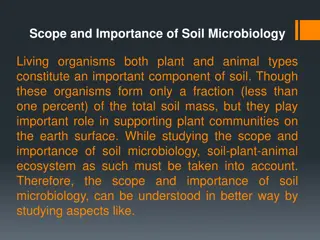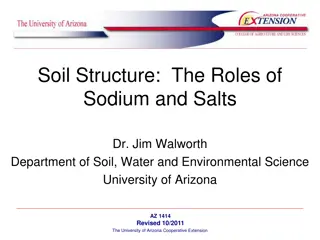Understanding the Role of Soil Biology in Lawn Care
Soil biology plays a crucial role in maintaining healthy and vibrant lawns. Various organisms, including invertebrates, plant roots, mycorrhizae, and micro-organisms, contribute to functions such as soil structure maintenance, regulation of soil hydrological processes, gas exchange, carbon sequestration, soil detoxification, nutrient cycling, decomposition of organic matter, suppression of pests and diseases, and symbiotic relationships with plants. By focusing on soil biology, lawncare enthusiasts can improve the overall health and resilience of their turf.
Download Presentation

Please find below an Image/Link to download the presentation.
The content on the website is provided AS IS for your information and personal use only. It may not be sold, licensed, or shared on other websites without obtaining consent from the author. Download presentation by click this link. If you encounter any issues during the download, it is possible that the publisher has removed the file from their server.
E N D
Presentation Transcript
Soil Biology in Lawn turf Ian Robertson
Look what's over the hill! The European Commission will propose a Soil Health Law in 2023. Such a legal framework will contribute to the achievement of the Soil Strategy 2030 objectives, grant soils the same level of protection as water and air water and air and radically the condition of soils to better provide the ecosystem services that we depend on. Will this affect lawncare? radically improve
Biggest asset to lawncare is you and your management of the soil There will be few pictures of lawns as the principles of soil biology are for all soils and plants grown on them
Biology is the driver of soils and therefore grass growth Functions Organisms involved Bioturbating invertebrates and plant roots, mycorrhizae and some other micro- organisms Maintenance of soil structure: functionality Most bioturbating invertebrates and plant roots Regulation of soil hydrological processes: Water Mostly micro-organisms and plant roots, some C protected in large compact biogenic invertebrate aggregates Gas exchange and carbon sequestration (accumulation in soil): Air Mostly micro-organisms Soil detoxification Mostly micro-organisms and plant roots, some soil- and litter-feeding invertebrates Nutrient cycling: food Various saprophytic and litter-feeding invertebrates (detritivores), fungi, bacteria, actinomycetes and other micro-organisms Decomposition of organic matter: cycle of food and reduction in thatch Plants, mycorrhizae and other fungi, nematodes, bacteria and various other micro- organisms, collembola, earthworms, various predators Suppression of pests, parasites and diseases: bio control better than chem Sources of food and medicines Plant roots, various insects (crickets, beetle larvae, ants, termites), earthworms, vertebrates, micro-organisms and their by-products Symbiotic and asymbiotic relationships with plants and their roots Rhizobia, mycorrhizae, actinomycetes, diazotrophic bacteria and various other rhizosphere micro-organisms, ants Plant growth control (positive and negative) Direct effects: plant roots, rhizobia, mycorrhizae, actinomycetes, pathogens, phytoparasitic nematodes, rhizophagous insects, plant-growth promoting rhizosphere micro-organisms, biocontrol agents Indirect effects: most soil biota
Ultimately soil is a living, breathing entity and must be treated as such
Soil Function limited by soil type/ health/ structure? Nutrient cycling: biological N is much more plant water efficient Carbon store Structural stability Speed of water movement through soil profile All influenced by management
Soil Functionality depends on 3 aspects Trophic layers Food source Texture Structure Biological Physical Chemical pH Nutrients
Clay is 1- 2 m Biology important at all stages to provide the glue to hold the soil together! - Humic particles bind tightly, roots hold more loosely
All these soils have the same pH, P, K, Mag levels, will they perform the same? Looking at things in isolation is dangerous
-ve charge -ve charge -ve charge -ve charge -ve charge -ve charge -ve charge -ve charge > -ve charge -ve charge Calcium has a 2+ charge and a large ionic radius therefore 'holds' onto soil colloids securely, but at a distance - hence flocculation. Magnesium also has a 2+ charge but a small ionic radius - therefore 'holds' onto soil colloids securely, but closely - hence coagulation Open Soils Tight Soil
How much of soil is soil? Ideal Soil Ideal Soil OGM 5% OGM 5% Air 25% Not Soil 50% Empty Mineral 45% Mineral 45% Water 25% Air Water Mineral OGM Not Soil Mineral OGM
3. Biology Biology interlink with many soil forming factors: - Acidification - Physical movement - Vegetation cover & degradation
Cant stop it so you must capture it. Soil microbes use 24 C/1N they store 8 and release 16 as Co2 . Fuelled by N
Decomposition of organic matter is largely a biological process that occurs naturally. Its speed is determined by three major factors: soil organisms, the physical environment and the quality of the organic matter (Brussaard, 1994). What areas can we control?
Clay is 1- 2 m Getting bigger in size Everything has to excrete = cycling nutrients 100 m 1-5 m 2-20 mm Cycle nutrients
Biology is the driver of soils and therefore grass growth Functions Organisms involved Ideal Soil Bioturbating invertebrates and plant roots, mycorrhizae and some other micro- organisms 5% Maintenance of soil structure: functionality OGM Most bioturbating invertebrates and plant roots Regulation of soil hydrological processes: Water Air 25% Mostly micro-organisms and plant roots, some C protected in large compact biogenic invertebrate aggregates Gas exchange and carbon sequestration (accumulation in soil): Air Mostly micro-organisms Soil detoxification Mostly micro-organisms and plant roots, some soil- and litter-feeding invertebrates Nutrient cycling: food Various saprophytic and litter-feeding invertebrates (detritivores), fungi, bacteria, actinomycetes and other micro-organisms Mineral 45% Decomposition of organic matter: cycle of food and reduction in thatch Plants, mycorrhizae and other fungi, nematodes, bacteria and various other micro- organisms, collembola, earthworms, various predators Suppression of pests, parasites and diseases: bio control better than chem Sources of food and medicines Plant roots, various insects (crickets, beetle larvae, ants, termites), earthworms, vertebrates, micro-organisms and their by-products Symbiotic and asymbiotic relationships with plants and their roots Rhizobia, mycorrhizae, actinomycetes, diazotrophic bacteria and various other rhizosphere micro-organisms, ants Water 25% Plant growth control (positive and negative) Direct effects: plant roots, rhizobia, mycorrhizae, actinomycetes, pathogens, phytoparasitic nematodes, rhizophagous insects, plant-growth promoting rhizosphere micro-organisms, biocontrol agents Indirect effects: most soil biota Air Water Mineral OGM
How do nutrients get in to the plant? Focus on Mass flow= soil functionality Mass flow The movement of nutrients in soil solution to the surface of the roots through the flow of water. The flow of the water is a result of wetting and drying or transpiration water uptake by the plants. The rate at which nutrients are taken up by mass flow is determined by the water in the soil and by the amount of water being taken up by the crop.
Grass 10 100 15 1.5 Fresh weight/Ha Fesh weight/ 100M2 Dm % Dry Weight T/Ha 25 250 15 3.75 50 500 15 7.5 Functional soils rootzone will give you 100-250Kg N/Ha 100-250 grams/100m2/year Kg/100M2 % of DM grams/100m2 45 5.25 42 4.5 2.25 1.5 micro grams 28.5 6 54 75 6 0.3 grams/100m2 grams/100m2 112.5 13.125 105 11.25 5.625 3.75 micro grams micro grams 71.25 15 135 187.5 15 0.75 N P K 3 225 26.25 210 22.5 11.25 7.5 0.35 2.8 0.3 0.15 0.1 Calcium Mag Sulphur PPM Mn B Zn Fe Cu Mo 19 4 36 50 4 0.2 142.5 30 270 375 30 1.5
Measure the biology PLFA: Soil life monitor SoilBioLab: Simon and microscopes Microbometer cards
SOIL LIFE MONITOR (PLFA) (PLFA) This is a lab test measuring the levels of bacteria, fungi and protozoa in the soil It also measures the diversity of the microbial biomass. This is a very useful test to see how diverse your soil biology is , the more diverse the better nutrient cycling and the more the soil will give you. Ideally tests before and after taking management actions.
Summary Summary Biology is very very important You can measure it PLFA Diversity test Manage Physics and chemistry to build the home Know what you want to grow (dm/m2) cycle or feed to this Many things make grass green (Fe, Mag, N, K etc) Make your own or buy from supplier: ensure the house is ready for it. Every action you do will affect biology
What can I add over and above my normal program? Microbial Bio stimulants Seaweeds Organic acids: Fulvic, Humic Biological inoculants : BioLevel Balancing fert to grass demand: Biological Nitrogen Amino acids Test the biology : PLFA: Prowlawncare
Get started Thank you Ian Robertson 07970286420 ian@soiladvice.com

























